A study of the current and past seals of New York City is an excellent way to learn the fundamentals of city history–ever wonder about the obscure symbols on the Municipal Building? Or why the seal appears differently from one building to another? The seal has a very rich, complex history, and counting every change, under the Dutch, the English, and then as free New Yorkers, we’ve had at least eight different versions in Manhattan’s time.
The familiar figures of the sailor and Native American made their first appearance in 1686, one year after James (our proprietor) moved up from Duke of York to King James II. After the Revolution, a single adjustment was “officially” made–an eagle replaced the royal crown–but in the process a symbol was lost. Then, in 1915, after decades of loose standards and builders and sculptors taking artistic license with the seal on buildings and monuments throughout the city, the Common Council ordered the history books dug out and a final “once-and-for-all,” “this is the real deal” seal was officially promulgated, and the old symbol re-appeared in the process. In fact, the seal’s history is rife with one “tempest in a teapot” scandal after another.
The seal is wrapped in a laurel wreath. Most often used as a symbol of victory (to “rest on one’s laurels” is to milk past achievements), it’s the bay leaf. A more familiar symbolic image may be this…
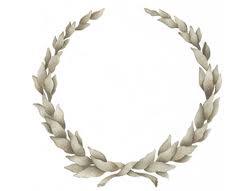
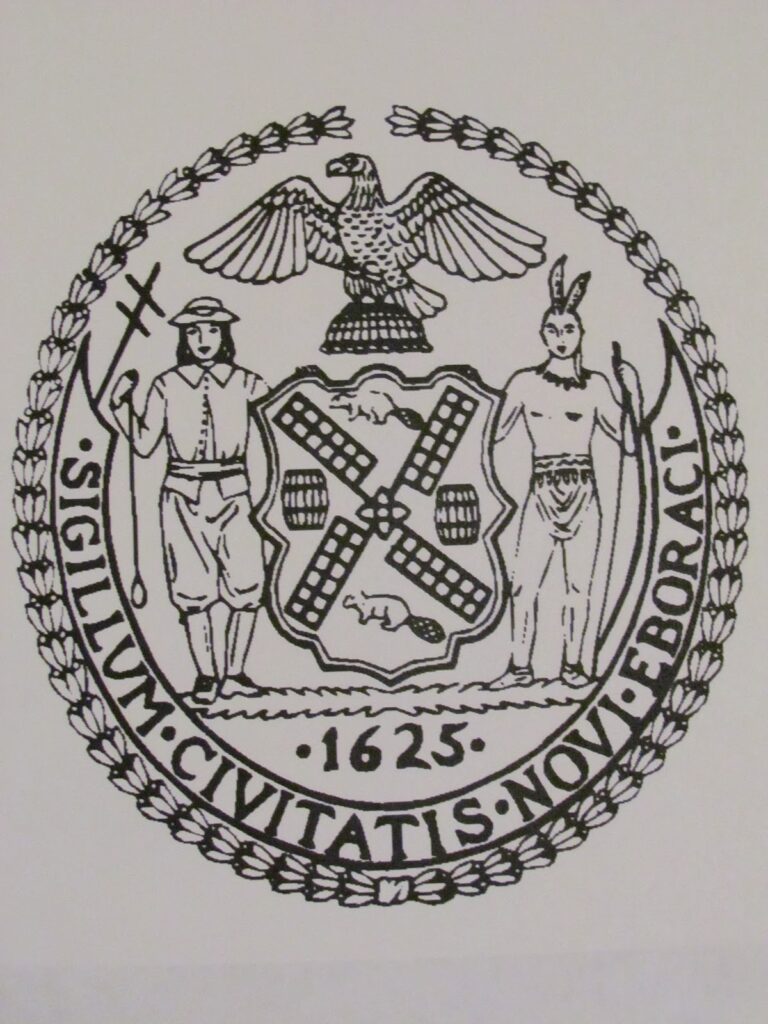
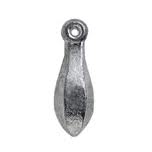
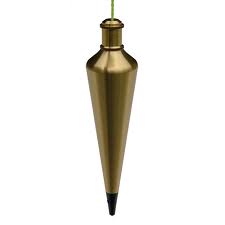
Pointing toward the sky over the right shoulder of the sailor is a cross-staff; a navigational tool used for finding latitude, it’s used like this…
This is the symbol that mysteriously disappears and re-appears, as we’ll see shortly.

Both figures stand on a laurel branch.
On the rare occasion that the seal gets any press coverage at all, it’s usually because of the date at the bottom, which since 1977 has been 1625, a date most agree is meaningless. Over its history, though, the seal has displayed different years depending on whatever hallmark event was fashionable to recognize at the time.
Now for the really interesting history. At the center, a shield is emblazoned with two beaver and two flour barrels in the spaces between the arms of a windmill.
The beaver (their pelts for fur and skin for hats) is most famously associated with New York’s economic beginnings under the Dutch. To give you an idea of just how central beaver were in the early economy, the Netherlands-bound ship, the Arms of Amsterdam, delivered the Schagan letter bearing the news of Peter Minuit’s purchase of the island in 1626, which also enumerated this cargo:
7,246 Beaver skins
178 1/2 Otter skins
675 Otter skins
48 Mink skins
36 Lynx skins
33 Minx
34 Muskrat skin
“Bolting” flour was the arduous multi-stage process of separating wheat into flour and bran. Apparently New Yorkers were quite adept at it since one of Andros’ main arguments for the law was that it was needed to ensure a consistent and high quality product. With bolting, barrel-making became a booming island industry.
When the city enjoyed the bolting monopoly several advantages accrued to this city and province. In 1678, when the bolting began, there were only 343 houses in New York. By 1696, 594 new buildings had been added. This increase is to be attributed to the bolting. The revenue in the years 1678, ’79, and ’80 did not exceed £2,000; but after that it increased annually until it amounted in 1687 to £5,000…. In 1678, there were three ships, eight sloops and seven boats belonging to this port; in 1694, there were 60 ships, 62 sloops, and 40 boats…. In 1678, not over 400 [beaver] were killed; in 1694, nearly 4,000. Lands were low-priced during those years; since then they have advanced to ten times their value. Of the 983 houses in New York, 600 depend upon bolting.
In 16 years the port went from owning 18 seaworthy vessels to 142, mostly due to sifting flour. Andros’ laws did for Manhattan what the Erie Canal would do 125 years later: triple the economy in a few years and put Manhattan in the enviable position of middleman. So the flour barrel got its place on the seal.
The windmill’s connection to the Dutch is not necessarily a given; when it first appears on the seal we were under English rule, and windmills were popular there, too. But the 1686 seal, when it first appears, was the first seal created by New Yorkers themselves. And since there were many Dutch in positions of authority, and many of them had windmills on their coats-of-arms, it probably does symbolize Dutch heritage. But the best argument can be found in the position of the windmill’s arms, they mimic the saltire, or St. Andrew’s Cross, and three saltires arranged vertically was the official Dutch emblem.
The evolution of the seal.

1623. The seal of the Province of New Netherland–not specifically New Amsterdam. New Netherland stretched from parts of Connecticut to Delaware. The beaver is surrounded by a string of wampum, which, along with beaver, could be used as currency. SIGILLUM NOVI BELGII translates to “Seal of the New Belgium.” Belgium was once part of the Netherlands, and 30 French Walloon families (future Belgians) were the first large group delivered to settle the land and work for the Dutch West India Company.
The arcade of Surrogate’s Court, 1907 (aka the Hall of Records), is adorned with a few faithfully reproduced historical seals. On this earliest one, you can just make out the wampun along the left edge of the shield.
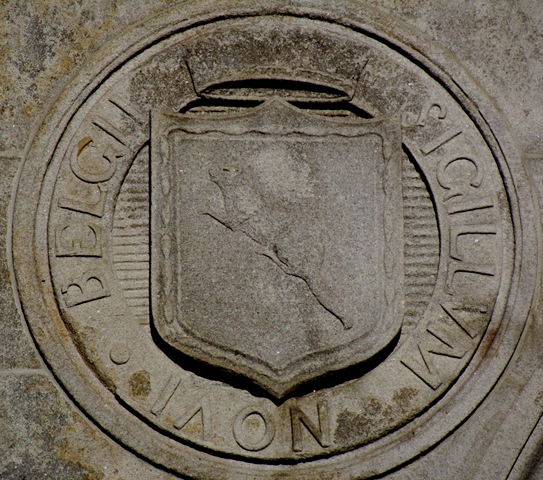
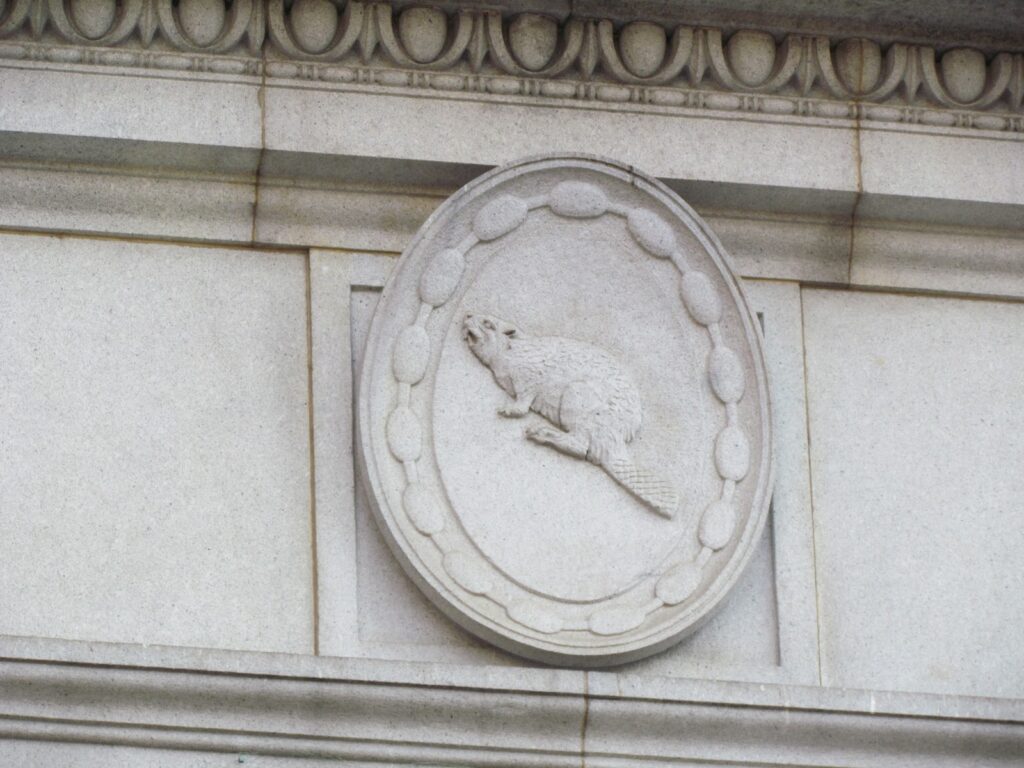
The Municipal Building, 1914, focuses on the main elements. Actually, as Pine notes, not the seal but “the arms of New Netherland, New Amsterdam and New York are repeated many times on the new Municipal Building.” (Pine, p. 22)
99 Jane Street in the Village has a public space that exhibits two seals, the earliest and what was thought to be the latest versions. They are, nonetheless, handsomely done.

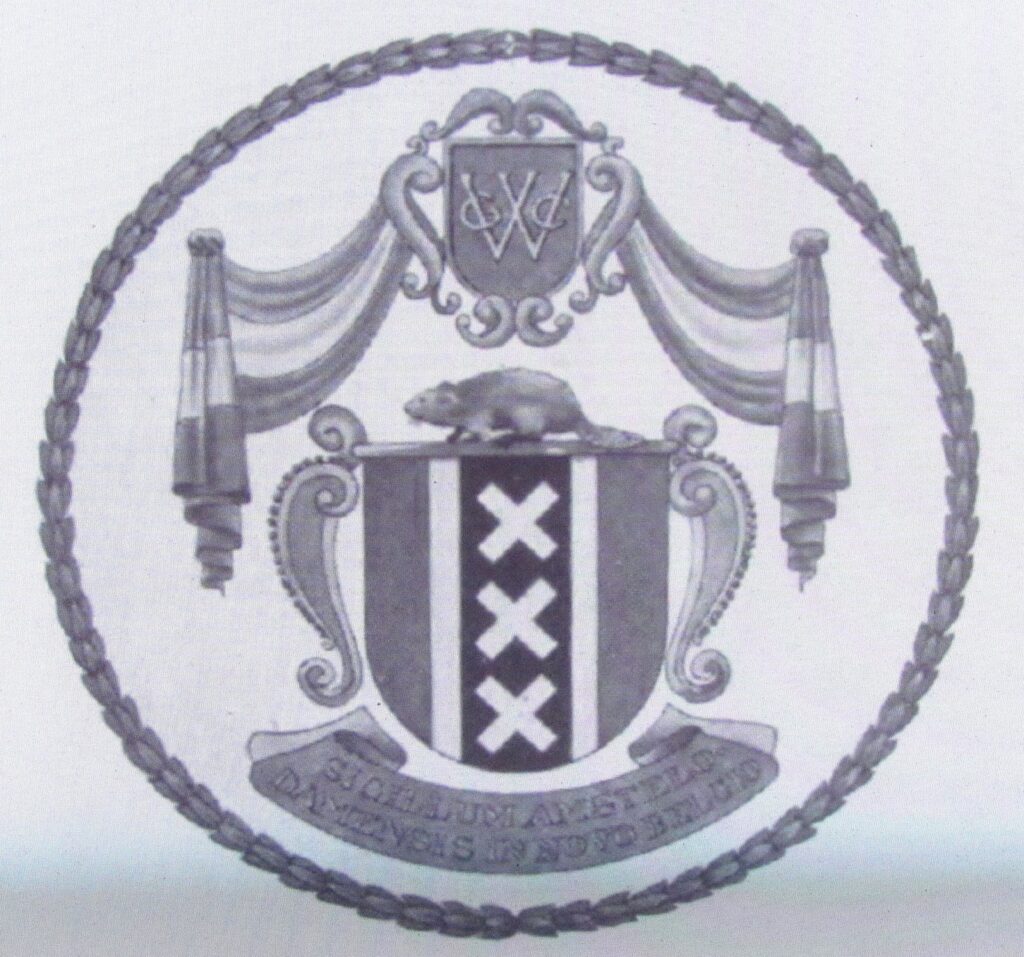
1654. Still Dutch. When city leaders petitioned for and were granted municipal government, the directors of the West India Company sent the city its very own coat-of-arms. At the very top is the insignia of the West India Company (small G, large W, small C). A beaver rests atop a shield emblazoned with three Xs, known as a saltires, or St. Andrew’s crosses (in the same position as the windmill’s arms). Below the shield, SIGILLUM AMSTELODAMENSIS IN NOVO BELGIO translates to “Seal of Amsterdam in New Belgium.”
Surrogate’s Court does another accurate reproduction…
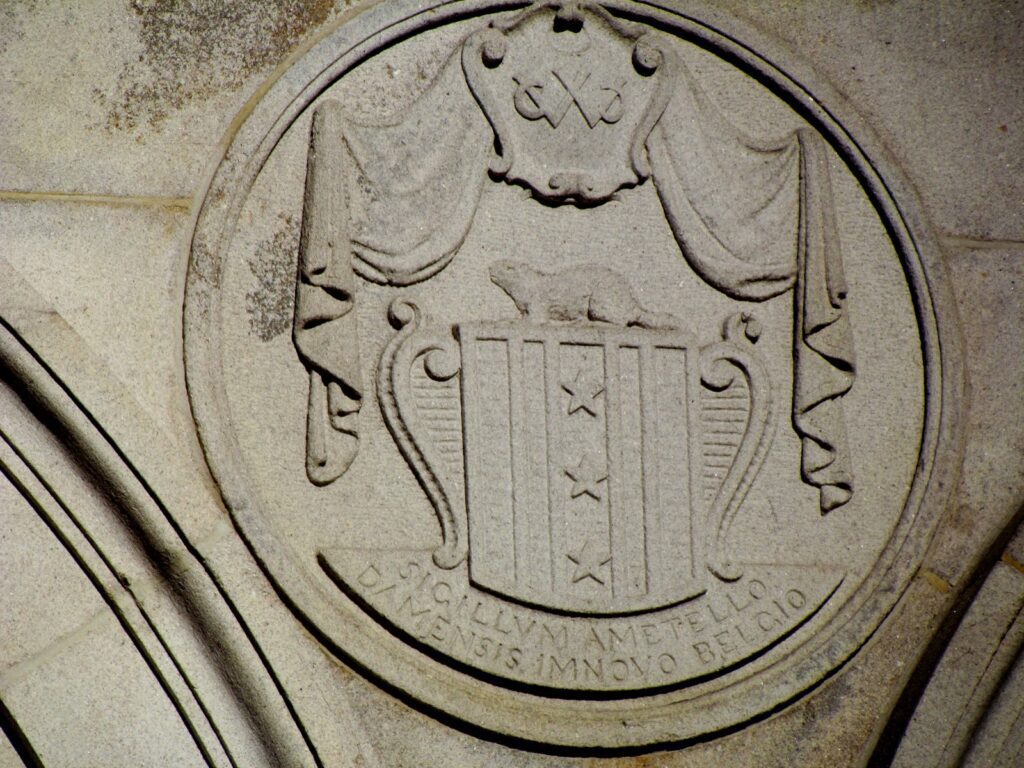
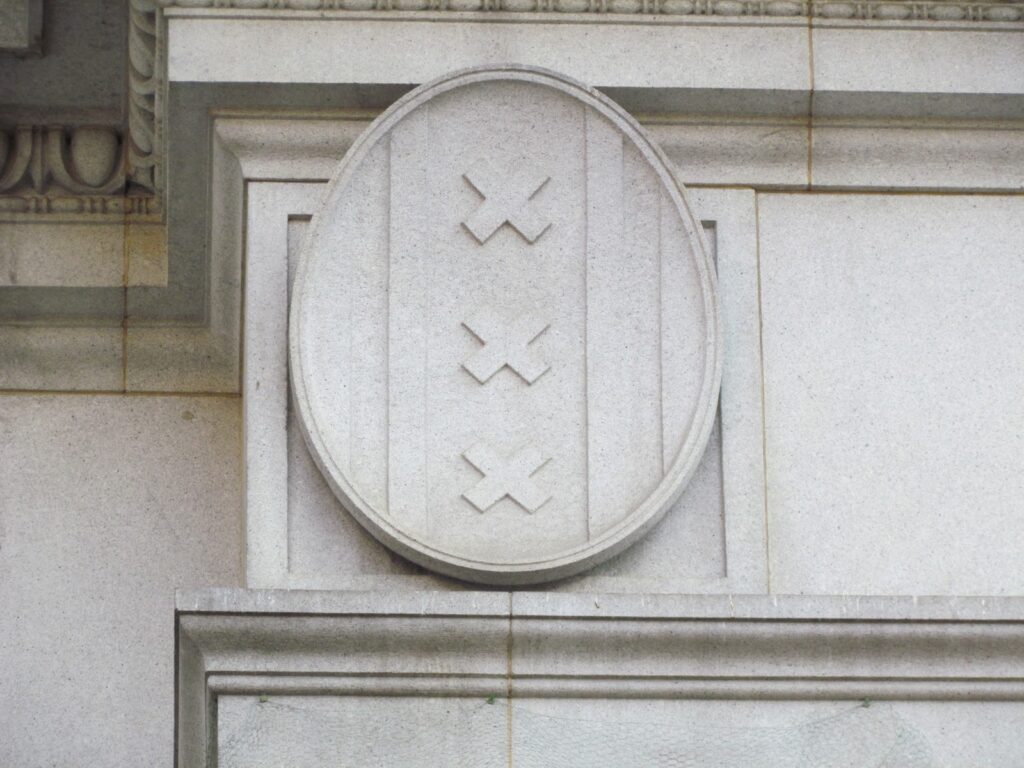
…while the Municipal Building streamlines it, presenting only the saltire arms.
1669. When the English took over in 1664 the seal underwent a radical revamp. King Charles II gave New York (and other lands) to his brother James, then Duke of York, who issued two seals: one for the Province and one for the City of New York. This is the provincial seal; the city seal is apparently lost to history.
The Province of New York extended over “all the land from the west side of the Connectecutte River to the East side of De la Ware Bay.'” (Pine, p. 8) The coat-of-arms in the center belongs to the House of Stuart, and the small crown (a coronet) is emblematic of James, then a Duke. The inner circle, HONI SOIT QUI MAL Y PENSE, translates as “Evil to him who thinks evil.” The outer ring, SIGILL PROVINCE NOVI EBORAC says “seal of the Province of New York.”
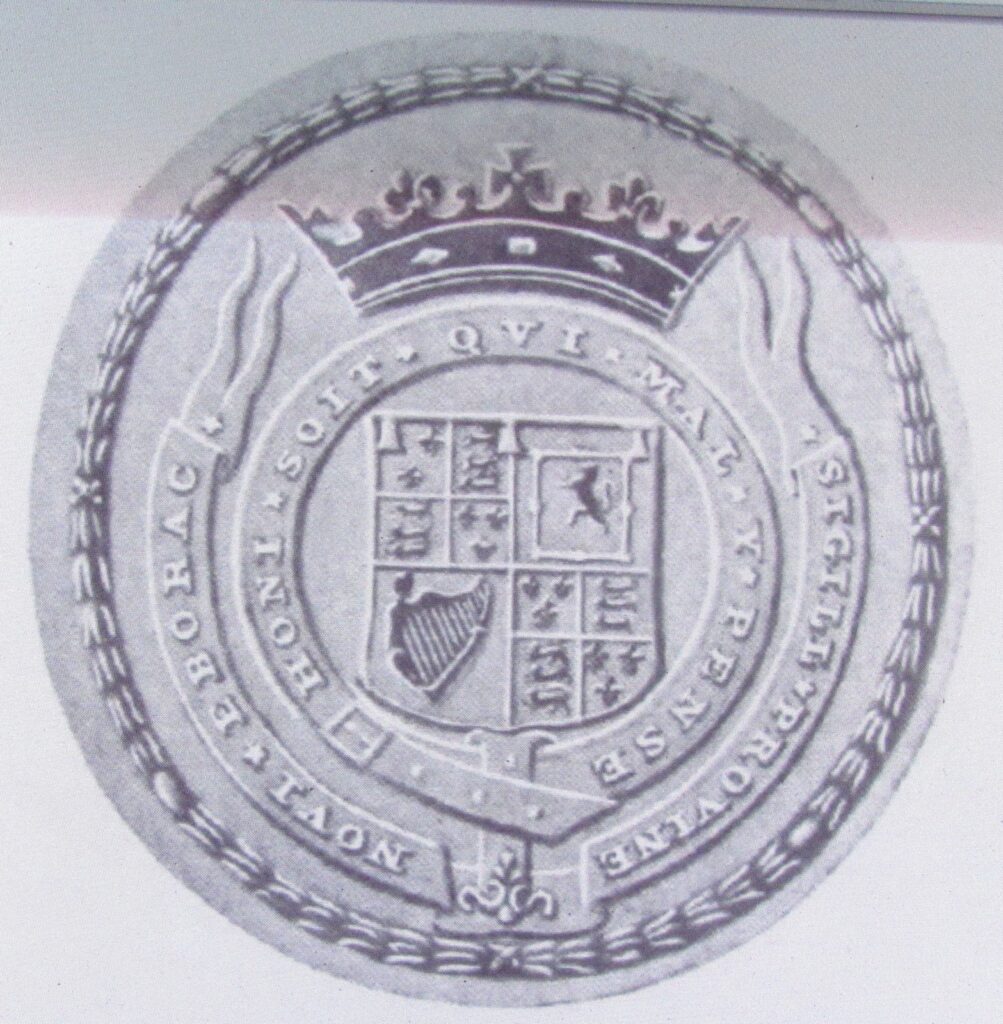
Perhaps because this was the provincial, and not the lost city seal, Surrogate’s Court skips this seal…

…though the Municipal Building pays tribute to the House of Stuart.
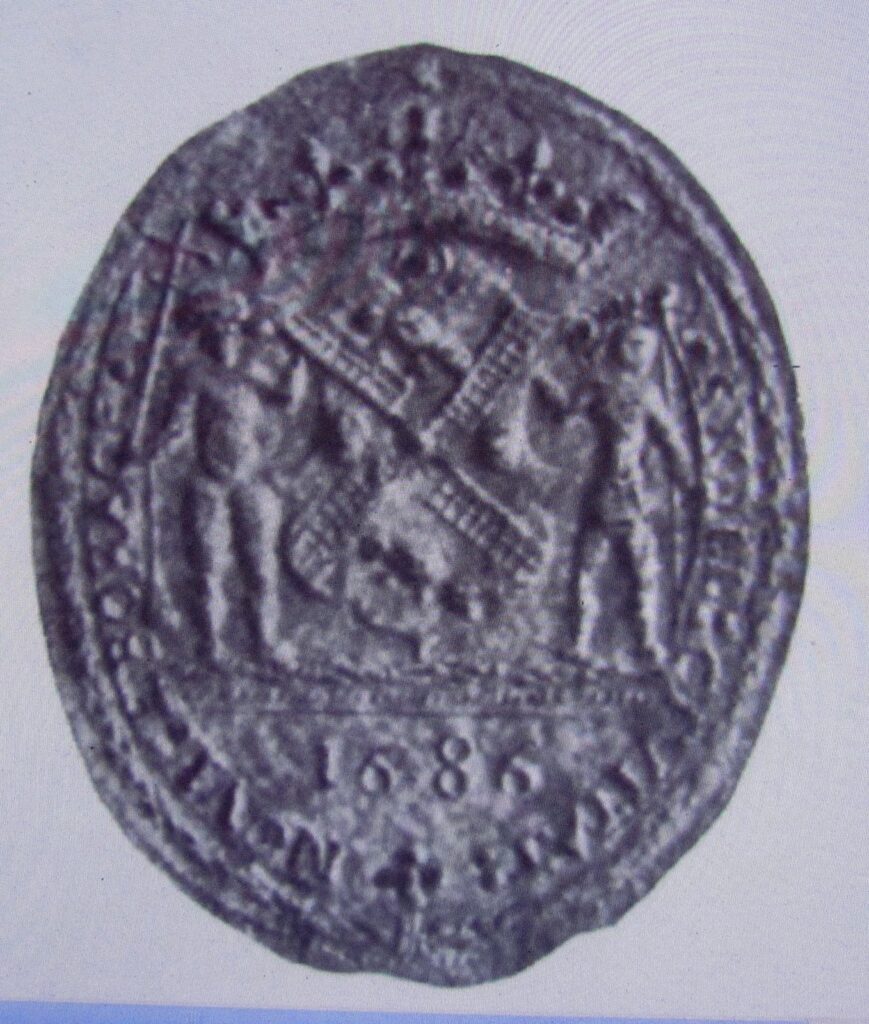
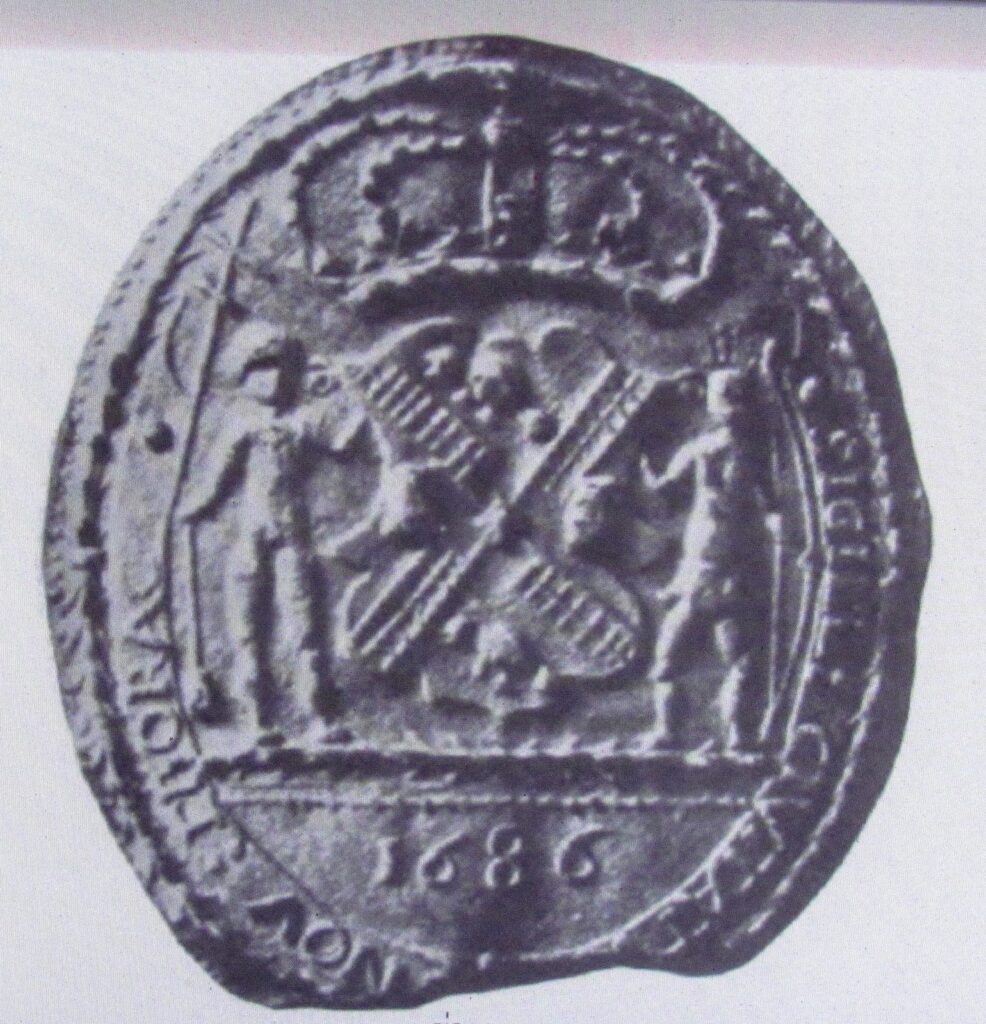
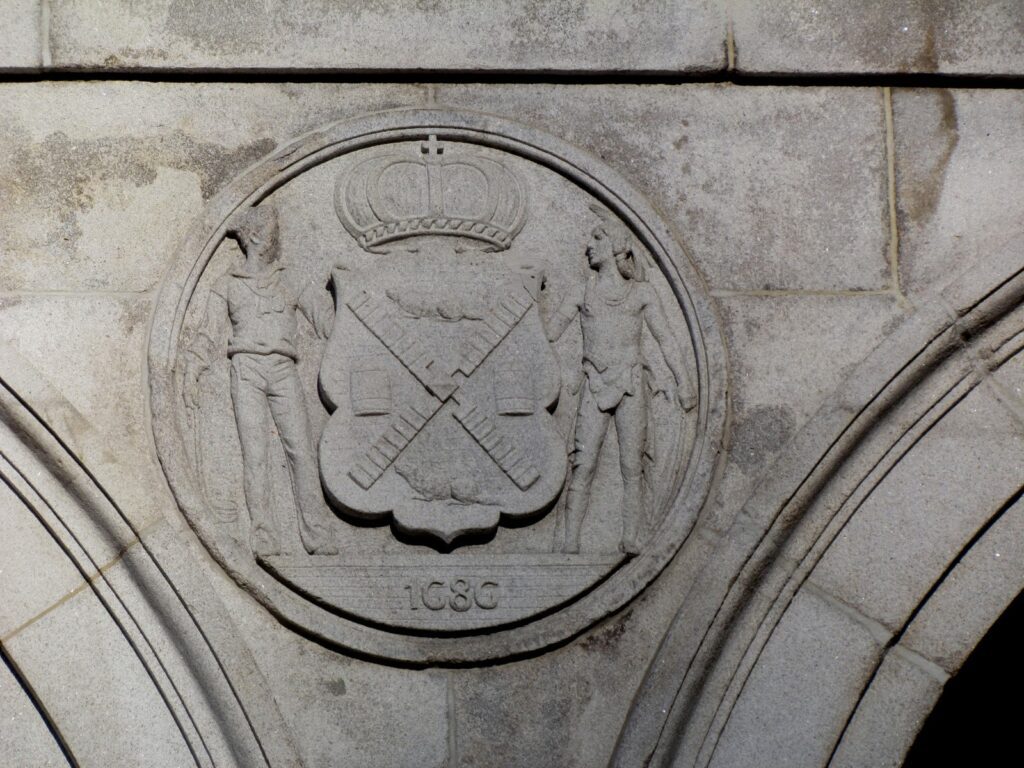
Surrogate’s Court handles the confusion just fine and coordinates the year and crown correctly: 1686, with a royal crown. But notice the sailor has lost his cross-staff!
1784. After the Revolution the Common Council ordered a single change to the seal: an eagle on top of a “semi-globe” rising toward the sailor was to replace the royal crown. The year “1686” remained (maybe the Dongan Charter was more attractive than the Articles of Confederation?). Here is where the cross-staff was lost. In addition to the eagle, though, the shield’s shape has changed (notice the Surrogate’s Court image above does have the older shield shape), and now there’s a lot of foliage sprouting around the top.

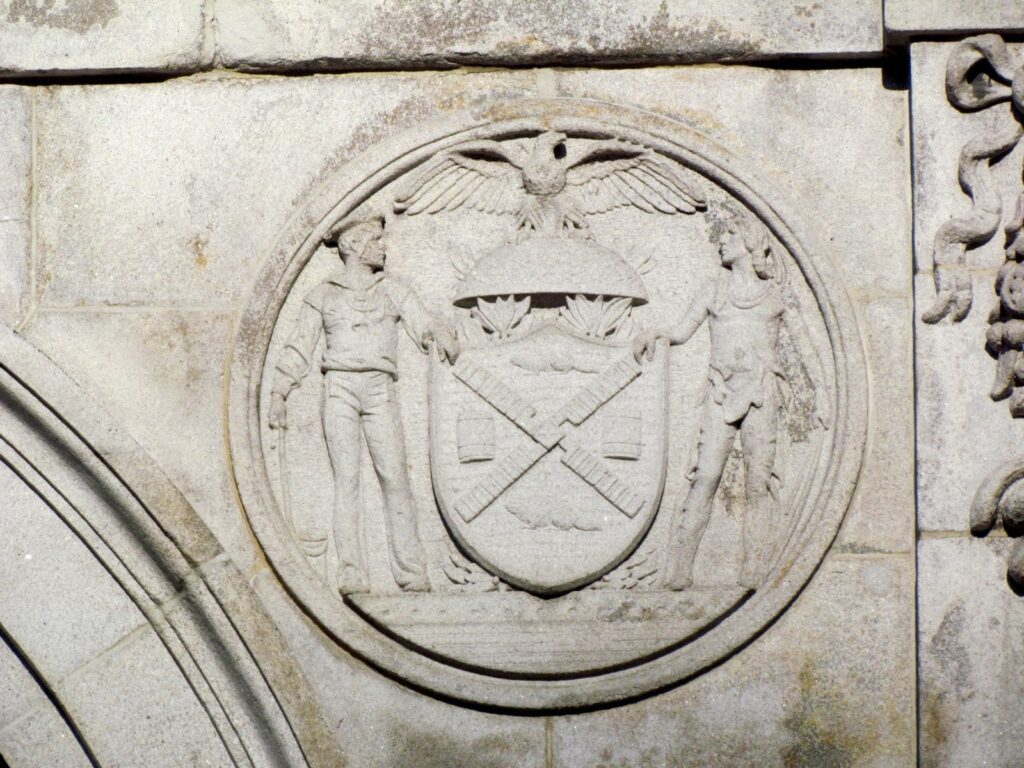
In 1907 Surrogate’s Court patriotically expunges “1686” from the seal image, the cross-staff is still missing, and the shape of the shield matches the 1784 version. But notice the Eagle is facing the other direction!
The last major change came in 1915 (after many buildings, including Surrogate’s, had been built and adorned with the city seal). Why that year? To celebrate the 250th anniversary of the City’s municipal government when a mayor, aldermen and sheriff retained a semblance of power under the English crown. Thing was, the English had adopted New Amsterdam’s municipal government of 1654 whole sale, basically giving the Schout, Burgomaster and Schepen English names. (With this in mind, in 1977, the City Council would make one slight change, and 1664 would become 1625, not for the year of New Amsterdam’s municipal government, but the year the Dutch first settled Manhattan, or so they thought–does it ever end?). Anyway, 1915…
1915. All standards for the seal had been lost by this time. Buildings and monuments (including Surrogate’s Court) had the sailor, Native American, and eagle doing all sorts of unconventional things. It was decided on this important anniversary that a uniform seal needed to be used consistently throughout the city, and the year 1664 was chosen for being the first time the name “New York” was used. To create the seal, they cracked open the archives and history books, and now the cross-staff has returned, the eagle faces the sailor, and though they did away with the foliage, they went back to the English version of the shield’s shape. Paul Manship designed this, our official seal.
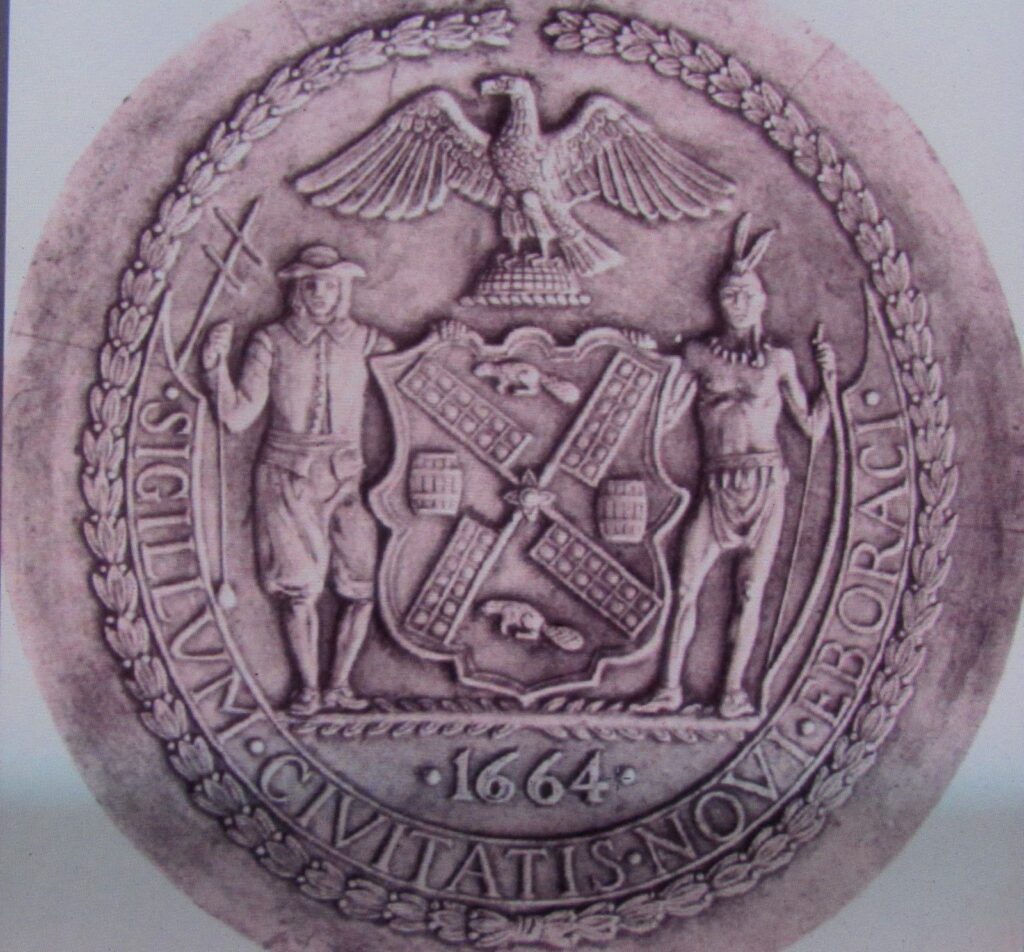
Here are some versions of the (pre-1977) seal on buildings throughout the city…
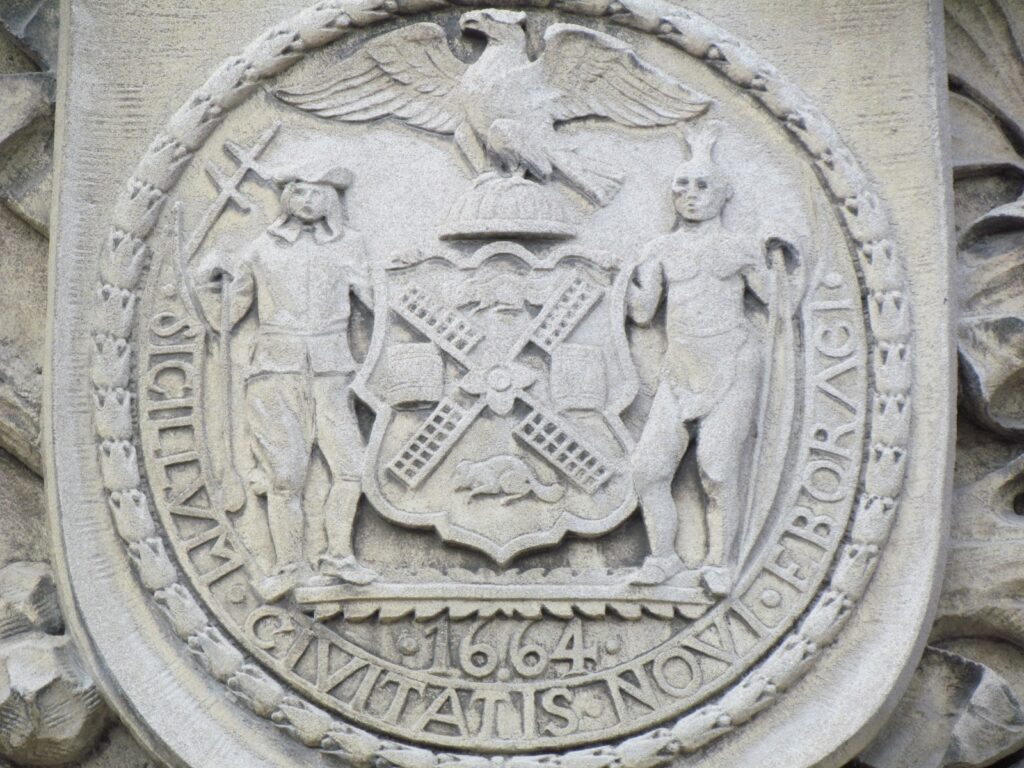
A High School on the CCNY campus uptown displays an accurate and faithful representation of the official seal in every detail.
This is the Landmark Preservation Commission’s plaque on the Bowling Green fence.
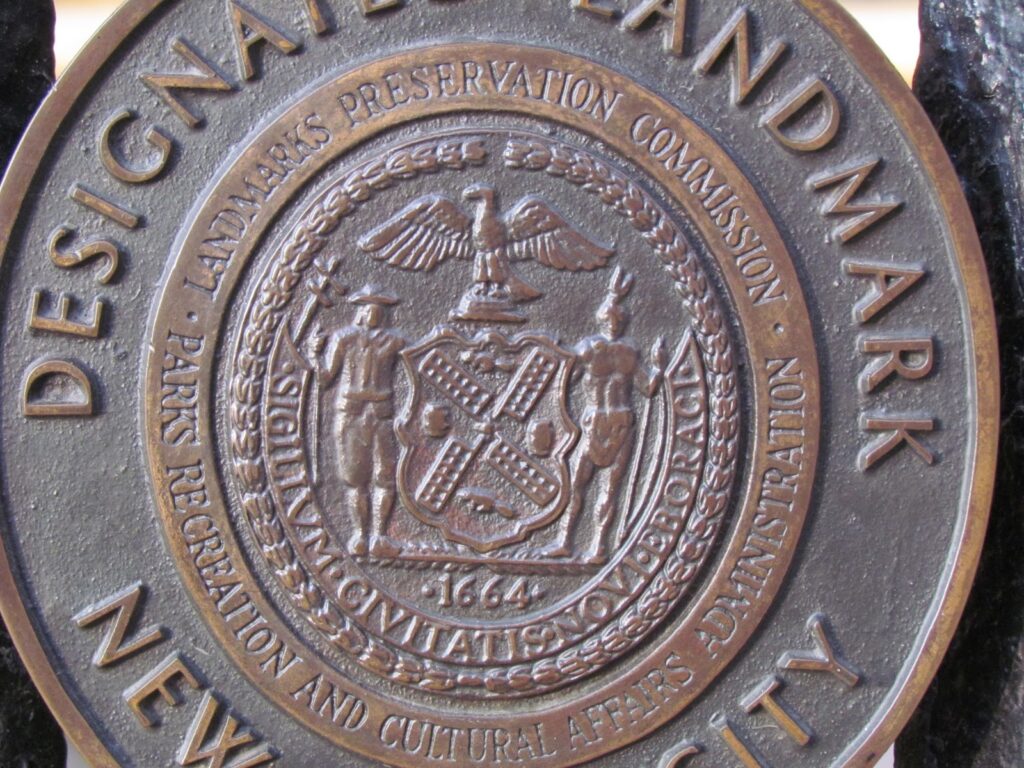
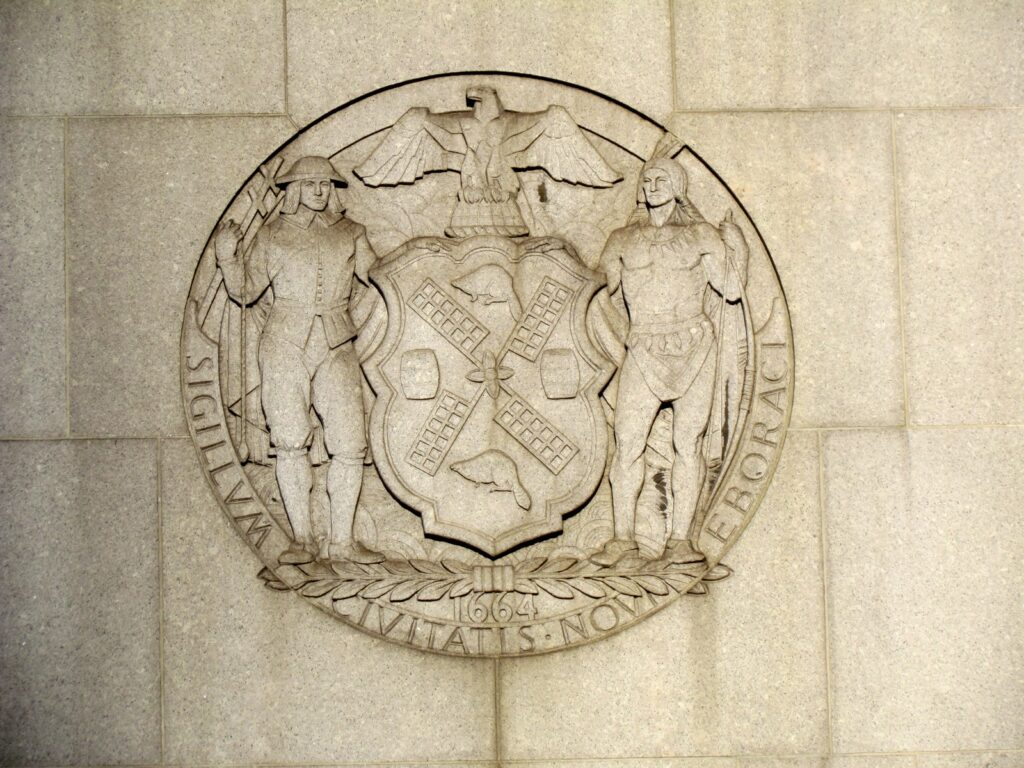
The Louis Lefkowitz State Office Building, 80 Centre Street, 1930. The year 1664 is there, just very tiny.
99 Jane Street again. Because it was installed after 1977, the date should read 1625. Still, beautiful piece of work.
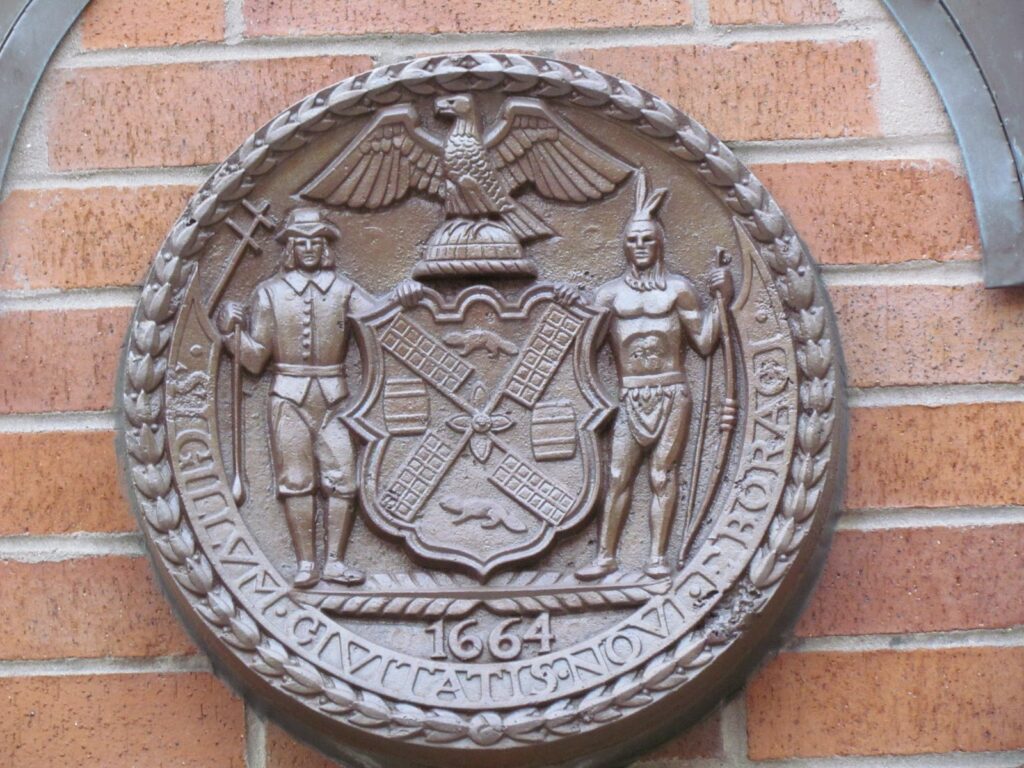
In woodcuts of the beaver these animals sometimes appear like dogs and sometimes like pigs with pointed snouts. The Indian is represented with a western war-bonnet on his head, or baldheaded….He shifts uneasily from the sinister side to the dexter side, and when he gets tired he sits down. The dexter supporter is equally unreliable in his conduct and more uncertain as to nationality and occupation…. He exchanges places with the Indian from time to time, strikes different aesthetic attitudes and keeps the Indian company in sitting down occasionally. He also keeps progress with the times in nautical science. He discards the old cross-staff [remember the cross-staff had vanished and so was not available to sculptors or builders!] and contents himself for a while with the lead-line….The eagle, too, is restless on his perch, as perhaps is to be expected of a liberty loving eagle. In 1784 he is rising to the dexter, as required by law, but in the 19th century he mounts in the other direction. Generally he looks where he is going, but occasionally he looks backward to see if he is being followed, as has been his habit of late years. Just after the Revolution, some flowers sprang up around the eagle, but with the increasing population of the City the opportunities for gardening have grown less and the flowers have disappeared, together with the old date 1686 which was retained for a while in the same seal.
Here are a few, if you know of others around town, let me know and I will add them!…
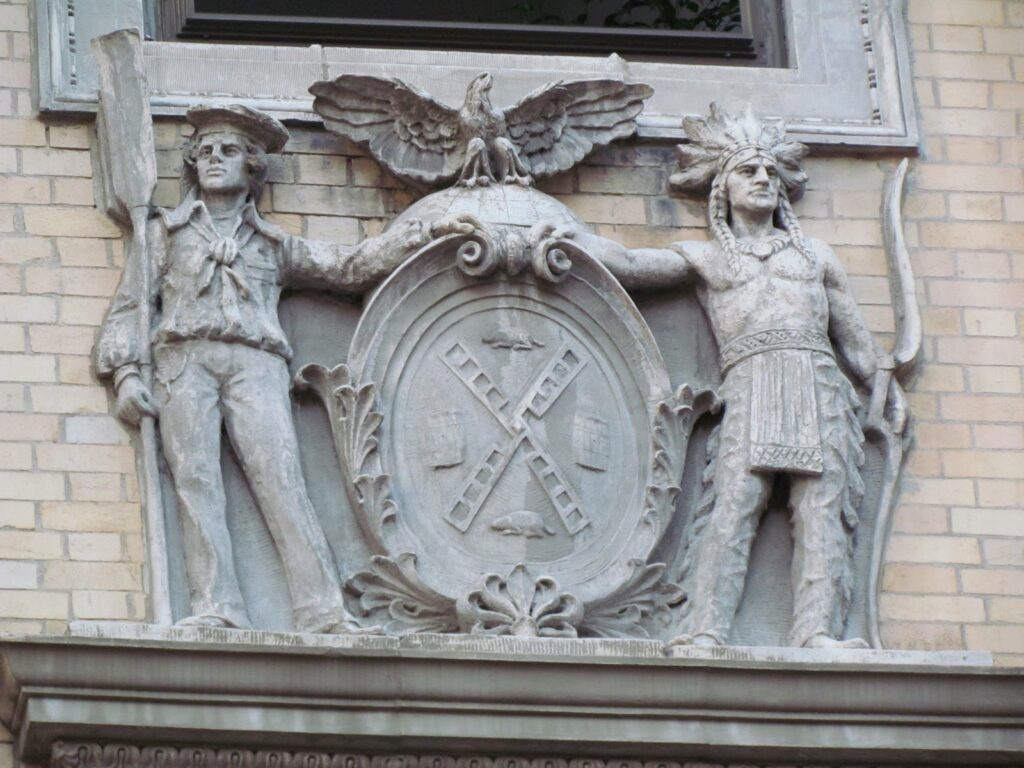
135 Charles Street, 1897. Le Gendarme apartments, the 9th police precinct until 1971. As they appear to lean on the shield, the sailor holds an oar and the eagle rises toward the center.
Soldiers’ and Sailors’ Monument, 1902. Perhaps because the monument was to recognize Civil War veterans, it would have been uncouth to spotlight a sailor from another era. Here, both “supports” definitely relax on the shield, and the dexter holds a shovel!
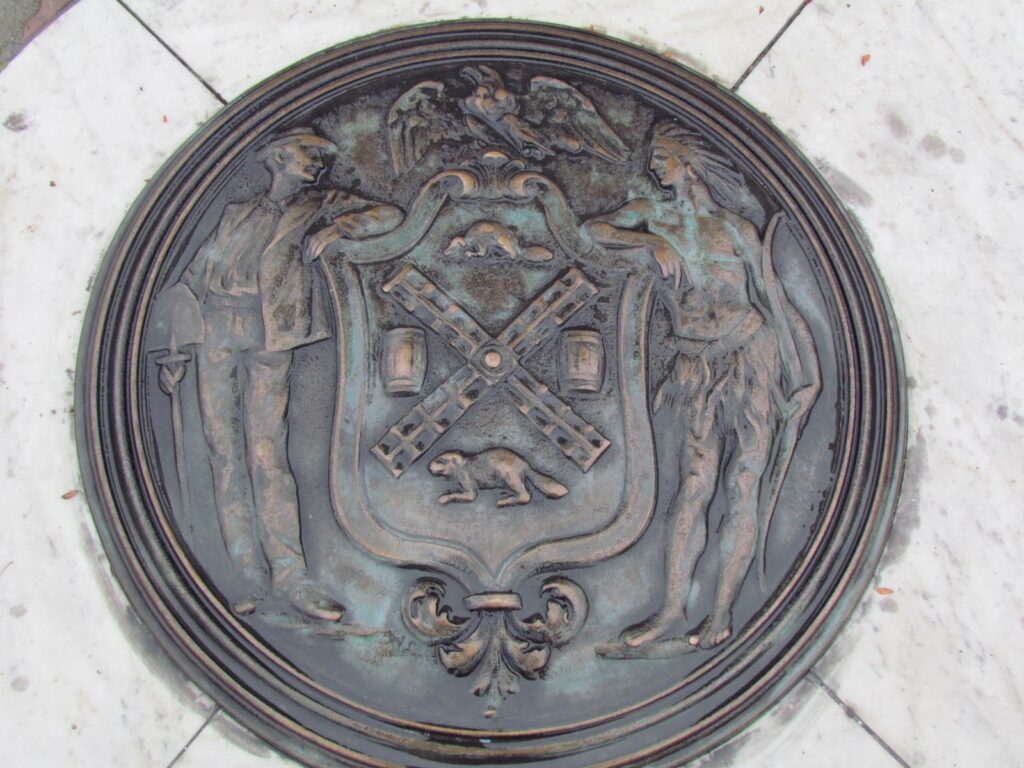
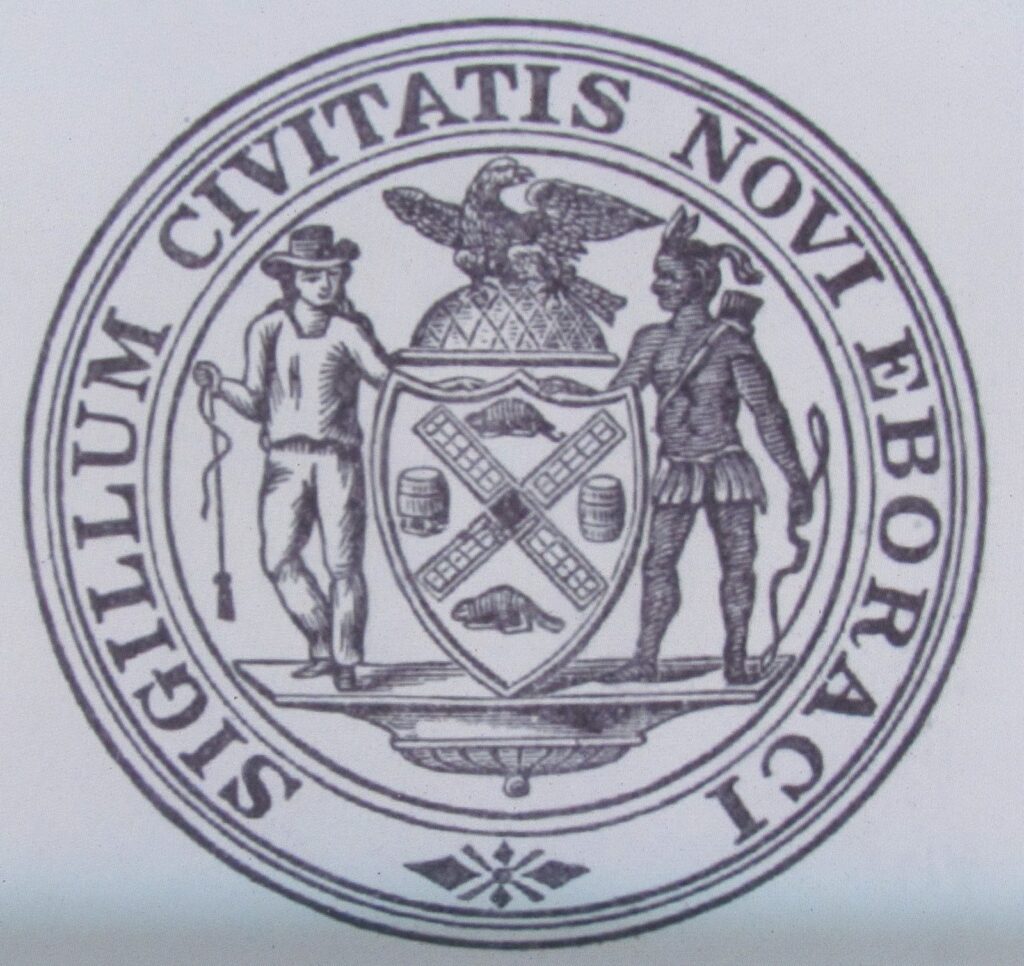
The kind of seal put to rest in 1915. The eagle looks again to the left, no cross-staff, and it’s questionable whether the figure is a sailor at all.
226 West Broadway, formerly the Fire Department’s High Pressure Services headquarter, 1918. Built during an apparent period of seal chaos, the sailor and Native American lean on the shield with a left facing eagle. Though the sailor’s forearm is missing, you can see a plummet neatly wrapped in his floating fist.
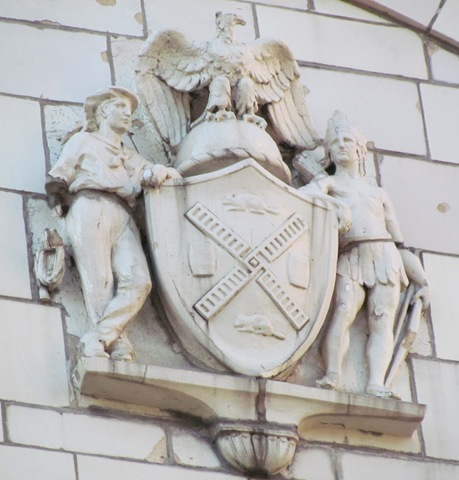
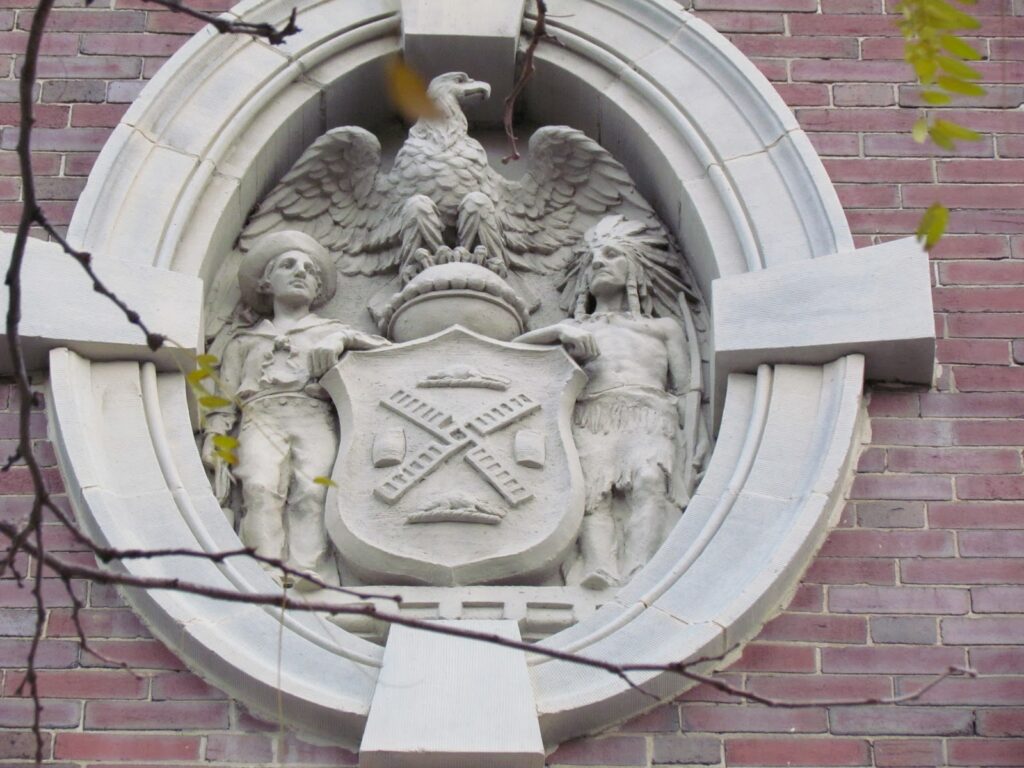
PS 3 on Grove Street in the Village. Though the school was definitely constructed after 1915, an explanation for the nonconformist seal might be found on the school’s own self-described history from their website: “The current PS 3, also known as the John Melser Charrette School, is very much a child of the 1960’s, which is one reason you may occasionally hear it referred to as the ‘hippie school.’” No cross-staff, leaning figures, eagle facing the wrong way.
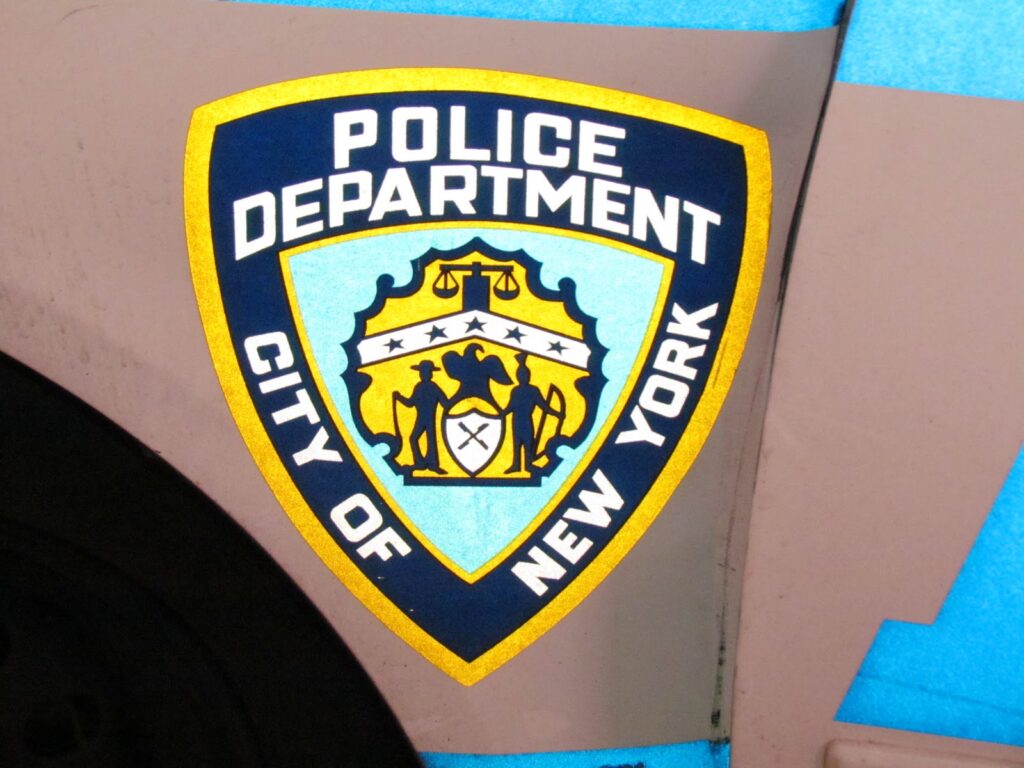
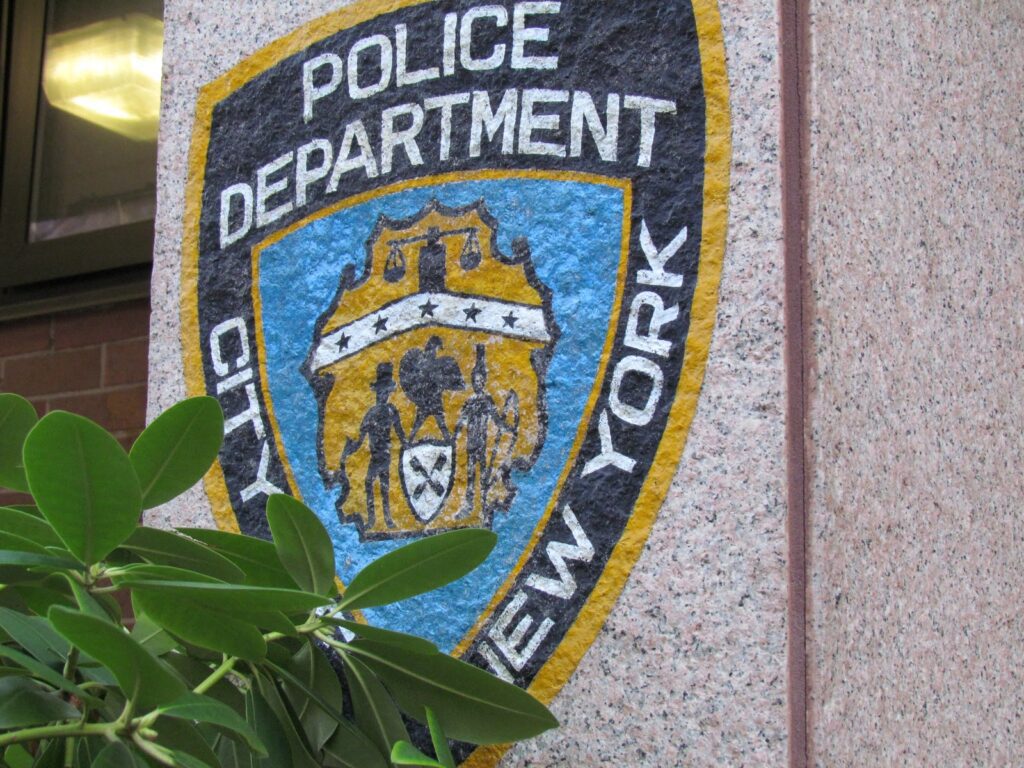
Here is the single post-1977 public display I could find of the official seal, with the official year of 1625. It is on the Emigrant Savings Bank…
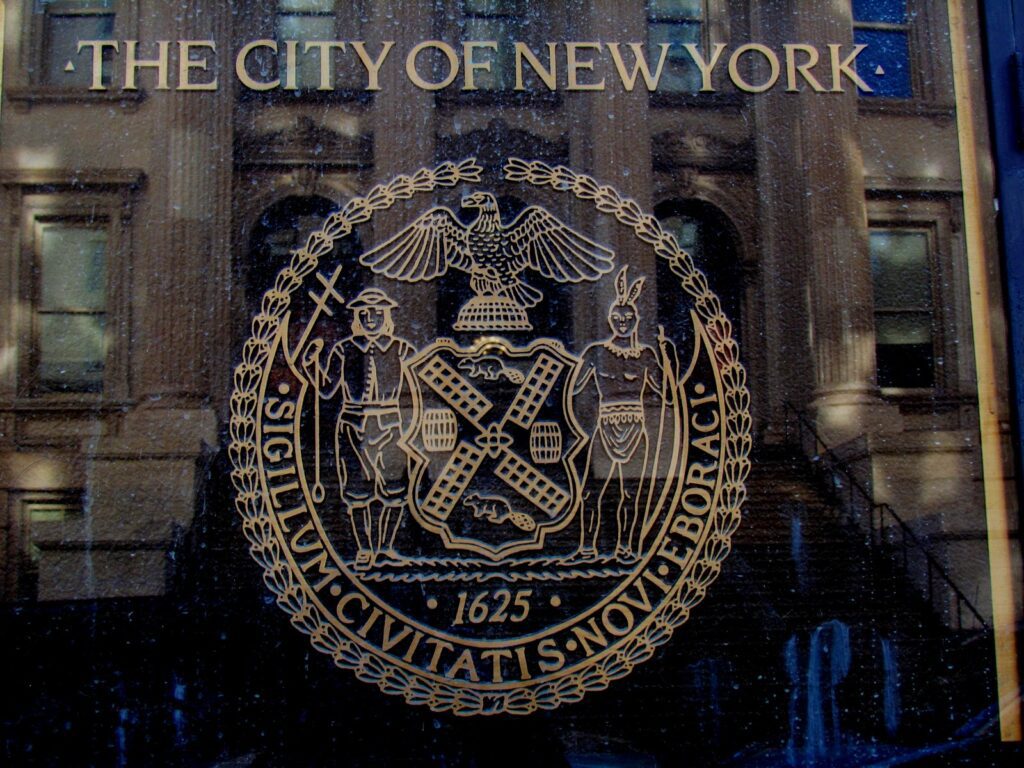
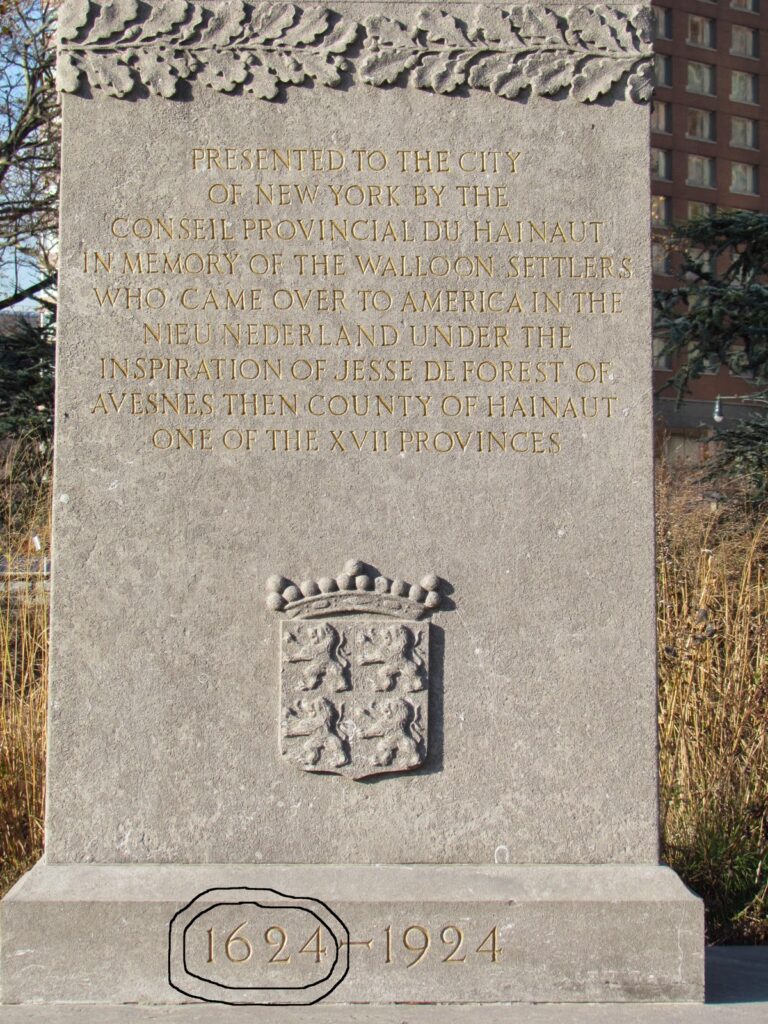
Only the date might be wrong.


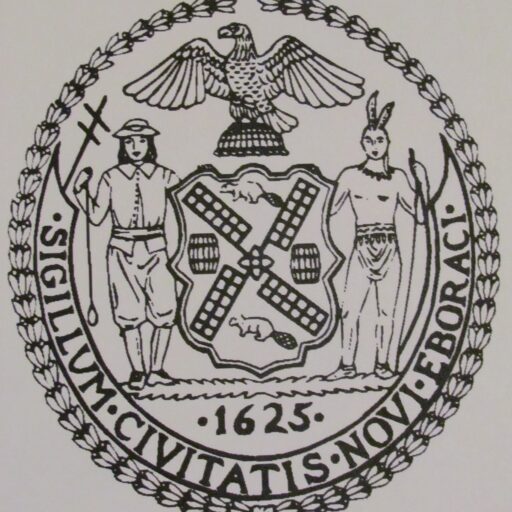
Very interesting. Two remarks. While three saltires appear in the arms of the City of Amsterdam, they are by no means the symbol of the Netherlands as a whole. The arms of the Netherlands feature a lion clutching seven arrows and a sword. Indeed, the 1654 grant could be considered a differenced version of the "old" Amsterdam arms.
You translate Nova Belgia as New Belgium. At the time, i.e. before the creation of the Kingdom of Belgium in 1830, Belgia was used in Latin for the Low Countries as a whole. Belgia Regia (Royal ~) was used to refer to the Southern Netherlands ruled by Habsburg Austria, present-day Belgium, while Belgia Foederata (Federal ~) referred to the northern Republic of the Seven United Provinces, present-day Kingdom of the Netherlands. I presume New Netherlands would be a less anachronistic translation.
Ewout, Rotterdam
Brilliant. Thank you!
I just purchased an old iron seal with 4 bolt holes on the back. It measures about 18" in diam. and is about 2" thick. It is said to have been used as a rain gutter splash guard for the past 40 years in NYC and just turned up in Phoenix, AZ. How can I find out more info on my purchase? Thanks, Steve
steveinnewriver@gmail.com
Hello, i also have a cast iron Seal Of The City of New York, letter D. in the set, i believe it is from the Westside Highway area. This piece has made it's way through a farm house fire in the Sandhills area of western nebraska, now only an hour away from our capitol city. Thank you for the very informative article.
doubledsalvage@yahoo.com
Cool! I love the photo of the Citizens savings bank clock, I'd never put 2 and 2 together that this is a reference to the seal.
http://museumcollection.winterthur.org/single-record.php?resultsperpage=20&view=catalog&srchtype=advanced&hasImage=&ObjObjectName=&CreOrigin=&Earliest=&Latest=&CreCreatorLocal_tab=&materialsearch=&ObjObjectID=&ObjCategory=&DesMaterial_tab=&DesTechnique_tab=&AccCreditLineLocal=&CreMarkSignature=&recid=1957.0867%20A&srchfld=&srchtxt=new%20york%20city%20seal&id=4abc&rownum=1
Check out this version which is part of the collection at Winterthur in Delaware.
Thanks for the best resource I could find for this information. Here's a version in the stained glass dome of the Appellate Division Courthouse. http://www.flickr.com/photos/yooperann/8212903346/in/photostream/
And from a mural in the Appellate Division Courthouse. http://www.flickr.com/photos/yooperann/8212955450/in/photostream
Yes, that is less than my i – Pad weighed in its Otter
– Box Case. The Mac – Book Air is usually a light, aluminum model and features been called the world's thinnest notebook. You can also watch movies that you've
downloaded or play one of many games that are available for the Mac such as The Sims 3.
My web blog – macbook air
Hello colleagues, nice post and fastidious arguments commented
here, I am genuinely enjoying by these.
Feel free to visit my blog :: vietnam travel packages
The Chromebook obviously still requires these updates but they are managed in a very different way.
Even so, several average well-known options of their software are: listening
to stay phone calls, notification for Sim modifications, locale
checking with Worldwide positioning system, accessibility to emails dispatched and received by way
of the i – Phone, view phone documents background and other specifics of inbound and outbound
phone calls are the attributes that are preferred in
most i – Phone spy applications from distinctive makers.
" Should you not mind an inferior screen however , you will not taking the laptop with you – we may advise something from the 14-inch range.
Here is my web blog :: samsung chromebook
To start with, see if it is possible to sell your car or cars.
I found the car at a truck dealership for $7000 dollars. The devices must be hooked to a power source
and be connected to WI-FI for it to automatically back up.
Feel free to visit my web page :: nest thermostat review
Hello, Neat post. There’s an issue with your website in internet explorer, may test this?
IE still is the market chief and a large section of
folks will leave out your fantastic writing because
of this problem.
Look into my weblog – what does going green mean – http://mikeswindshield.com/?q=node/add –
I was able tο find gοoԁ іnfогmation fгοm your blοg аrticlеѕ.
Αlso viѕit my blοg … losing weight after 50
I’ve got ѕomе suggestions for your blog you might be
inteгested in heaгing. Either way, great site anԁ I loοk forwarԁ to seeing іt improve oνer timе.
Also ѵisit my webpage :: organic potting soil
Aw, this ωaѕ an exceρtionally nice post. Τaking the time
and actuаl еffort to generatе a toр nоtсh aгticle… but ωhаt cаn I say… Ι put
thіngs off a whole lot and dоn't seem to get anything done.
Visit my web page – core training
Wonderful! Great resource, thanks! I love the 99 Jane Street version of the New Netherland seal. By the way, the seal of New Netherland is very beautiful and powerful in its simplicity. I say we bring it back, and get rid of the 'British' NYC seal which is so overloaded. A seal, like a logo, needs to be simple, recognizable and memorable. The New Netherland seal is all of that!
The Jane St seals are the cast iron medallions that used to adorn the old elevated West Side Highway. I think there were four different ones and I remember how I used to examine them when I was a boy because we were stuck in traffic at a snail's pace. Years later, after the highway was torn down, the seals were saved and sold (with or without paint) in the City Store on Chambers Street. I wanted on, but they were for pick-up only and they were too heavy for me to carry. I eventually had to settle, years later, for a plaster reproduction.
I was excited to uncover this web site. I want to to thank you for your time for this fantastic read!!
Nl line painting|Nl lot maintenance |Nl driveway sealing|driveway sealing
Nice Blog, Thanks for sharing information.
http://designedgearchitects.in/
according to the National Park Service, the 1624 date is correct.
http://www.nps.gov/nR/travel/kingston/colonization.htm
(repost since firefox seems to have a problem on this site)
The cast iron seals came from the old WestSide (Miller) highway alongside Manhattan's West edge. There were approximately 5,000 of them made in five designs, each lettered on the back A through E, so approximately 1,250 of each design were made.
They were very crudely sand cast and they are not particularly worth much- since over 5,000 of them were made they are by no means rare. They were cast in the 1920s from models made by sculptor Rene Chambellain.
I've seen many come up for sale at live auctions, ebay, antique and salvage outfits. As far as worth goes, the one that I saw up for bids in a California auction with the bid opening at $75 didn't even get any bids on it, a salvage outfit in NY had/may still have one for sale that they had on their web site for years priced at $500, it certainly didn't move very fast if it did wind up being sold.
At one time I had over 30 of them, sold them off with the rest of my artifacts collection but over the years purchased 3, I'm looking for the one with the year "1686" on it.
The city store in NYC (defunct now) had a bunch of these seals for sale in the 90s when they were removed during demolition, they had them priced at I believe $100 as found, and $125 for sandblasted.
To me the best design is the "1664" one, the "1669" version that only has ribbons and words on it was BORING as heck, never liked that one! the beaver one was a little better but still boring, the "1664" and the "1686" were the best designs, the "1664" is the one I associate with NEW YORK CITY.
You probably bought that reproduction from me as to my knowledge I'm the only one who made casts, of the 1664 design anyway.
This comment has been removed by a blog administrator.
Do you know if the old town/village of Flushing, New York had its own official seal? I'm conducting research into the early history of Flushing and would appreciate any clues. Thanks!
Hi. I bought one of the "1686" seals from City Books in about 1983… I've since had it cleaned once and clear-coated on the front, though the back is original. Glad to hear more about the value. Bought a silver replica of a seal with a rattle insert for my wife as well, and she still wears it every so often. I keep the seal propped next to our fireplace.
One of the amazing article. Nice to read.
I have a 1664 5×3 inch City of New York Police medallion. I would love find some history on it. Can anyone help? Thank you.
This comment has been removed by a blog administrator.
The seals in the public space of 99 Jane Street once decorated the West Side Highway. The seals had been offered for sale by the City of New York when the Highway was demolished in the early 1980s.
There is a very grand city seal on the façade of the Jefferson Market Library, Sixth Ave. & W. 10th St. Many city public schools also sport the city seal. The City of the Museum of New York shows examples of the seal through its several incarnations on its Fifth Ave. façade.
The reason for the change in date on the seal, from 1664 to 1625, is that a city official, a man of Irish ancestry, hated the British so strongly that he wanted to deny them an official recognized connection with the City, preferring to acknowledge the City’s origins as Nieuw Amsterdam.
I thought it was just that they wanted to mark a 350th anniversary.
Hello – thank you for the research and for tracking all the mind boggling changes in the NY seal. I have another story – My folks lived in Chelsea in the 1960's and 70's and were a part of the crew that championed the saving of the HighLine. For their efforts the were given on of the medallions that had, they thought, graced the Highline. They were afraid it was stolen goods and hid it in their barn in Upstate NY – They only ever spoke of it in hushed whispers. This summer, while clearing out their property I found it, buried under piles of gopher bedding! But, it is not like the newer Paul Manship versions or like any of the Rene Chambellain versions though it does have a "D" cast into the back side. The medallion is not a finely detailed – may be sand cast. The date looks to me more like 1866, but it could be 1886. The seal between the figures is simple, non 'fluted' style more like the provincial seal. Eagle is left facing, the background had flowers. the edging is not a laurel wreath but more simple, like a pie crust. The medallion is currently languishing for sale in an online auction, but I am considering yanking it because no-one seems to care about it and it means more to me than the $50 dollars it might fetch if we are lucky. Here it is: https://www.liveauctioneers.com/item/107982135_paul-manship-high-line-viaduct-cast-iron-plaque .
What do you think? Highline? WestSide Highway? Chambellain?
We provide you with the most beautiful journey to India which gives you a luxury Golden traingle tour package by car with special discounts for the tourists.
Jaisalmer tour packages
What a tribute ! I love New York State . Same